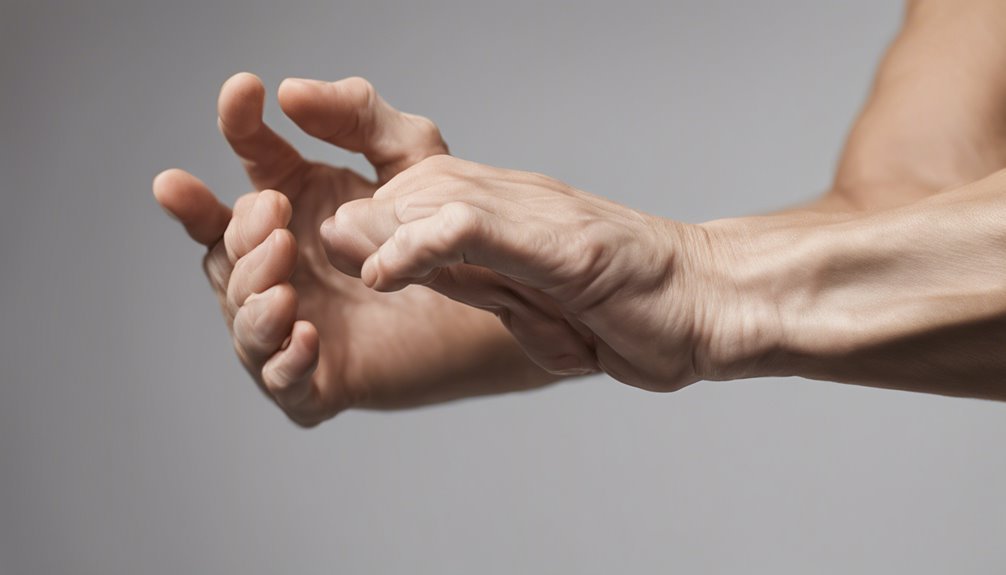You’ve probably heard carpal tunnel stretches can help ease pain and boost your grip strength, but do you know why they’re effective? Understanding the anatomy of your wrist and how symptoms develop is key to addressing the root causes of discomfort. While stretches like the wrist flexor and median nerve glide are popular, there’s more to uncover about how they specifically target tension and enhance flexibility. So, what makes these exercises so crucial, and how can they fit into a broader strategy for managing Carpal Tunnel Syndrome? Let’s explore the essential techniques and their impacts.
Understanding Carpal Tunnel Syndrome

When understanding Carpal Tunnel Syndrome (CTS), it’s essential to know that this condition stems from the compression of the median nerve within the carpal tunnel. You may experience pain, numbness, and tingling in your hands and fingers. These symptoms often develop gradually and can be particularly troublesome at night or during activities involving repetitive hand movements, such as flexing or extending your wrist for extended periods.
Women, especially during pregnancy, are more susceptible to CTS due to hormonal changes and swelling, though symptoms usually resolve after childbirth. Repetitive wrist movements, alongside pre-existing health conditions like diabetes and rheumatoid arthritis, increase your risk of developing this syndrome. Anatomical factors, such as having a smaller carpal tunnel, can also contribute to the pressure on your median nerve.
Early diagnosis and treatment are vital to prevent permanent nerve damage and muscle atrophy in your hand. If you suspect you have CTS, seeking medical advice promptly is crucial.
Treatment options may include wrist splinting, activity modification, and, in some cases, surgical intervention. Managing your symptoms early can significantly improve your quality of life and restore hand function.
Anatomy of the Wrist
The wrist is a complex structure consisting of eight carpal bones, which form the foundation for its stability and flexibility.
The carpal tunnel is a narrow passageway that houses the median nerve and several tendons essential for hand movement and sensation.
Understanding how these components interact can help you recognize and address issues like Carpal Tunnel Syndrome, where swelling affects the median nerve.
Carpal Tunnel Structure
The carpal tunnel is a crucial structure in your wrist, acting as a narrow passageway formed by the carpal bones and the transverse carpal ligament. You’ll find the median nerve and nine flexor tendons within this tight space.
The median nerve is essential for sensation in your thumb, index, middle, and part of the ring finger. However, swelling or inflammation in this area can significantly reduce the tunnel’s size, putting pressure on the median nerve. Such pressure often results from repetitive motions or trauma, leading to carpal tunnel syndrome, which can severely impact your hand mobility and overall sensation.
Consider these important points about the carpal tunnel:
- Narrow Passageway: Only about 2.5 centimeters wide.
- Houses the Median Nerve: Critical for hand sensation and function.
- Contains Flexor Tendons: Nine tendons that facilitate finger movement.
- Susceptible to Swelling: Inflammation can compress the median nerve.
- Linked to Carpal Tunnel Syndrome: Often caused by repetitive wrist motions.
Understanding the carpal tunnel’s structure helps you recognize how easily it can become compromised.
Maintaining wrist health through stretches and mindful movement is crucial to prevent issues like carpal tunnel syndrome.
Median Nerve Function
Delve into the fascinating role of the median nerve, a vital component running from your forearm into the palm of your hand. This nerve is crucial for sensation in your thumb, index, middle, and part of the ring finger and for controlling the muscles at the base of your thumb.
The median nerve function becomes apparent as it navigates the carpal tunnel, a narrow passage in your wrist formed by the carpal bones and the flexor retinaculum ligament.
When the median nerve faces compression within this tunnel, it leads to carpal tunnel syndrome, presenting symptoms like numbness, tingling, and weakness in your wrist and hand.
These symptoms of carpal tunnel can significantly affect daily activities. The median nerve is responsible for coordinating fine motor skills, so tasks requiring dexterity, such as typing or buttoning a shirt, become challenging when the median nerve isn’t functioning properly.
Understanding the anatomy and median nerve function helps you recognize carpal tunnel syndrome’s impact on your life.
Addressing this condition promptly can improve hand function and reduce discomfort, ensuring you can easily continue to perform intricate tasks.
Tendons and Ligament Role
Shifting focus from the median nerve‘s function, let’s explore the intricate role of tendons and ligaments in the wrist’s anatomy. These structures are crucial for both movement and stability.
The wrist comprises eight carpal bones, forming the carpal tunnel, where the median nerve and flexor tendons reside. These tendons are essential for bending your fingers and wrist, allowing precise hand movements. However, swelling or inflammation in the flexor tendons can elevate pressure on the median nerve, leading to carpal tunnel syndrome (CTS).
Ligaments, conversely, connect bones, providing essential stability. The transverse carpal ligament, for example, forms the roof of the carpal tunnel. Any thickening or injury to this ligament can narrow the tunnel, exacerbating CTS symptoms.
To better understand the role of tendons and ligaments, consider these points:
- Tendons connect muscles to bones for movement.
- Ligaments, like the transverse carpal ligament, ensure stability.
- Swelling in flexor tendons can lead to increased median nerve pressure.
- Ligament thickening can contribute to carpal tunnel narrowing.
- Recognizing these structures helps in managing wrist conditions like CTS.
Understanding these components helps recognize and treat wrist issues effectively.
Common Symptoms

You might notice tingling and numbness in your thumb, index, middle, and part of the ring fingers, especially at night.
Hand weakness and pain radiating from the wrist to the forearm or shoulder can make grasping small objects challenging.
These symptoms often worsen with repetitive wrist movements or certain sleeping positions, but they can improve with targeted stretches and exercises.
Tingling and Numbness
Tingling and numbness in the hand often signal Carpal Tunnel Syndrome (CTS), primarily impacting the thumb, index, middle, and part of the ring fingers.
These sensations arise from median nerve compression, especially during activities involving prolonged wrist flexion, like typing or using a mouse. You might notice that tingling and numbness worsen at night, disrupting your sleep.
If left unaddressed, these symptoms can lead to a burning sensation and eventually affect your grip strength, making daily tasks challenging. Early recognition of these signs is crucial to prevent nerve damage and ongoing discomfort.
Consider incorporating the following strategies to manage symptoms:
- Exercises: Gentle stretching can alleviate pressure on the median nerve.
- Wrist positioning: Maintain a neutral wrist position to reduce strain.
- Breaks: Regular breaks during repetitive tasks can mitigate symptoms.
- Ergonomic adjustments: Optimize your workspace to minimize wrist flexion.
- Professional consultation: Seek medical advice if symptoms persist.
Hand Weakness and Pain
Many people experience hand weakness and pain as prevalent symptoms of Carpal Tunnel Syndrome (CTS). These issues arise because of median nerve compression, leading to reduced grip strength and difficulty with tasks requiring fine motor skills. About 50% of those with CTS notice weakness, especially in the thumb, index, and middle fingers. This can make the hand feel clumsy, and people might drop objects more often. If left untreated, these symptoms can worsen over time.
Pain from CTS usually starts at the wrist and can radiate up to your forearm. It often worsens with repetitive wrist movements or holding your wrist in one position for too long. Notably, many find that their symptoms, including hand weakness and pain, worsen at night or after extended use, impacting both daily activities and sleep quality.
To manage these symptoms, consider exercises that can help reduce pressure on the median nerve and improve grip strength.
Understanding your treatment options is crucial. Explore methods that address the immediate symptoms and the underlying causes of CTS, helping you regain functionality and reduce discomfort in your daily life.
Causes and Risk Factors
Carpal tunnel syndrome (CTS) often arises from repetitive hand movements, leading to inflammation and swelling of the tendons within the carpal tunnel. These repetitive motions are a primary cause of CTS, but several other risk factors can increase your chances of developing this condition. Recognizing these factors can help you manage and possibly prevent CTS.
Key risk factors include:
- Gender: Women are three times more likely to experience CTS than men, especially during pregnancy.
- Medical Conditions: Health issues like diabetes, obesity, and rheumatoid arthritis can lead to swelling and nerve compression.
- Age: As you age, particularly after 30, the risk of nerve compression increases.
- Occupational Hazards: Jobs requiring prolonged wrist flexion, use of vibrating tools, or exposure to cold environments elevate CTS risk.
- Hormonal Changes: Pregnancy-related hormonal shifts and fluid retention can contribute to CTS.
Understanding these causes and risk factors can help you make informed choices about your daily activities and occupational practices.
Effective Stretching Techniques

Understanding carpal tunnel syndrome’s causes and risk factors is just the first step in managing this condition.
Let’s dive into effective stretching techniques to reduce symptoms and improve flexibility. Start with wrist flexor stretches. Hold each stretch for 30 seconds and repeat 2-4 times. This helps alleviate tension in your wrist and forearm muscles.
Next, try the median nerve glide exercise. This involves holding various hand positions for 3-7 seconds and repeating the sequence 10-15 times daily. It’s great for enhancing nerve mobility and reducing discomfort.
Remember finger stretches. Spread your fingers wide, hold, and relax. Do this up to four times to relieve tightness and improve hand flexibility.
Incorporating the prayer stretch is another excellent way to maintain wrist flexibility. Press your palms together and lower them to your waist. Hold for 15-30 seconds and repeat 2-4 times. This will help alleviate discomfort.
Lastly, perform wrist rotations. Move your hands in different directions to enhance wrist mobility and reduce stiffness. Aim for up to four repetitions to keep your wrists supple and functional.
Strengthening Exercises
Strengthening exercises are key to managing carpal tunnel syndrome. They can greatly improve grip strength while reducing symptoms. Focusing on your hand and wrist can make daily activities easier and more comfortable.
Here are a few exercises to incorporate into your routine:
- First to Stop Sign: Make a fist, then extend your fingers upwards. Repeat 5-10 times to enhance muscle coordination and grip strength.
- Thumb Touches: Touch each fingertip to your thumb. This improves dexterity and strengthens the hand’s intrinsic muscles.
- Wrist Curls: Using a 1-pound weight, perform wrist curls to target the wrist flexors and extensors. Aim for 10 repetitions, up to three times daily.
Consistent practice of these exercises can help reduce symptoms within weeks.
Focus on both strengthening exercises and stretching for optimal results.
Incorporating these strengthening exercises into your daily routine can significantly improve your grip strength and reduce the symptoms of carpal tunnel syndrome.
Regular practice helps not only in alleviating discomfort but also in enhancing your overall hand and wrist function.
Safety Tips for Exercises

When engaging in exercises for carpal tunnel syndrome, it’s essential to prioritize safety to prevent further injury.
Begin by warming up your muscles with heat for about 15 minutes. This will enhance flexibility and prepare your muscles for the exercises.
As you perform stretches, focus on maintaining proper posture. Proper posture ensures that you avoid unnecessary strain on your wrists and hands, which can exacerbate symptoms.
Pay attention to how your body feels during each exercise. Mild discomfort is normal but stop immediately if you experience any sharp pain. Sharp pain indicates something might be wrong, and continuing could lead to further injury.
After completing your exercises, apply ice for about 20 minutes. This helps alleviate inflammation and soothe any discomfort.
Don’t hesitate to consult a healthcare provider if you have any questions about your exercise routine or if your symptoms worsen. They can offer personalized advice and modify your regimen, ensuring you do what’s best for your condition.
Lifestyle and Ergonomics
After ensuring exercise safety, it’s equally important to consider lifestyle and ergonomics to manage carpal tunnel syndrome effectively. Maintaining an ergonomic workspace helps prevent strain on your wrists and the median nerve.
Start using a keyboard and mouse that keep your wrists neutral. This adjustment can significantly reduce pain and the risk of developing carpal tunnel syndrome.
Regular breaks are crucial. During repetitive tasks, take a break every 30 to 60 minutes. This simple habit can prevent fatigue and reduce the risk of wrist injuries.
Engaging in exercises that strengthen your hands and wrists, combined with proper ergonomic practices, enhances grip strength and overall hand function.
Consider incorporating wrist-friendly tools to improve comfort and minimize pressure on the median nerve. These tools include:
- Ergonomic chairs: Support your back and encourage good posture.
- Wrist supports: Provide additional comfort and support.
- Adjustable workstations: Keep your forearms parallel to the ground.
- Stretch breaks: Incorporate stretches to relieve tension.
- Regular exercise: Strengthen your wrists and hands.
When to Seek Professional Help

Persistent numbness or tingling in the hands and fingers can be concerning, especially if they last more than a few weeks. Such symptoms might signal worsening carpal tunnel syndrome.
When these symptoms interfere with daily activities, such as gripping objects or performing tasks that require fine motor skills, it’s crucial to consult a healthcare provider. They can properly assess your condition and determine the best course of action.
If you’re dealing with severe pain that radiates up your arm or disrupts your sleep, don’t hesitate to seek professional help. This discomfort shouldn’t be ignored, which could lead to further complications.
A noticeable decrease in grip strength or muscle atrophy in your hand is another red flag. These changes can result in irreversible damage if not addressed promptly.
Sometimes, conservative treatments such as stretching and rest are insufficient to relieve symptoms. Consult a healthcare provider if these measures don’t improve your condition within a few weeks.
They can guide you through additional treatment options to alleviate discomfort and restore hand function.
Frequently Asked Questions
Can You Increase Grip Strength With Carpal Tunnel?
Targeted exercises, such as ball squeezes and thumb exercises, can increase grip strength even in people with carpal tunnel. Use proper technique and gradually increase intensity to avoid worsening symptoms. Consistency is key.
Can You Fix a Carpal Tunnel by Stretching?
You can’t completely fix carpal tunnel just by stretching, but regular stretches can significantly reduce symptoms and improve hand function. Combine them with ergonomic changes and consult a healthcare provider for a comprehensive approach.
Can Carpal Tunnel Cause Weak Grip?
Yes, carpal tunnel can cause a weak grip. You might notice difficulty holding objects because the median nerve is compressed. This compression often reduces strength in your thumb, index, and middle fingers, affecting everyday tasks.
How Do You Regain Grip Strength After Carpal Tunnel Surgery?
Start grip-strength exercises as your healthcare provider advises. Use tools like a rubber ball or therapy putty, and practice daily tendon gliding exercises. Gradually increase resistance, monitor your comfort, and adjust to regain strength.
Conclusion
Incorporating carpal tunnel stretches and strengthening exercises into your daily routine can significantly reduce pain and improve grip strength. By understanding your wrist’s anatomy and being aware of common symptoms and causes, you can take proactive steps to manage your condition. Remember to follow safety tips and adjust your lifestyle and ergonomics to prevent further strain. If symptoms persist, don’t hesitate to seek professional help. Consistent practice and proper care can make a difference in your hand function.

